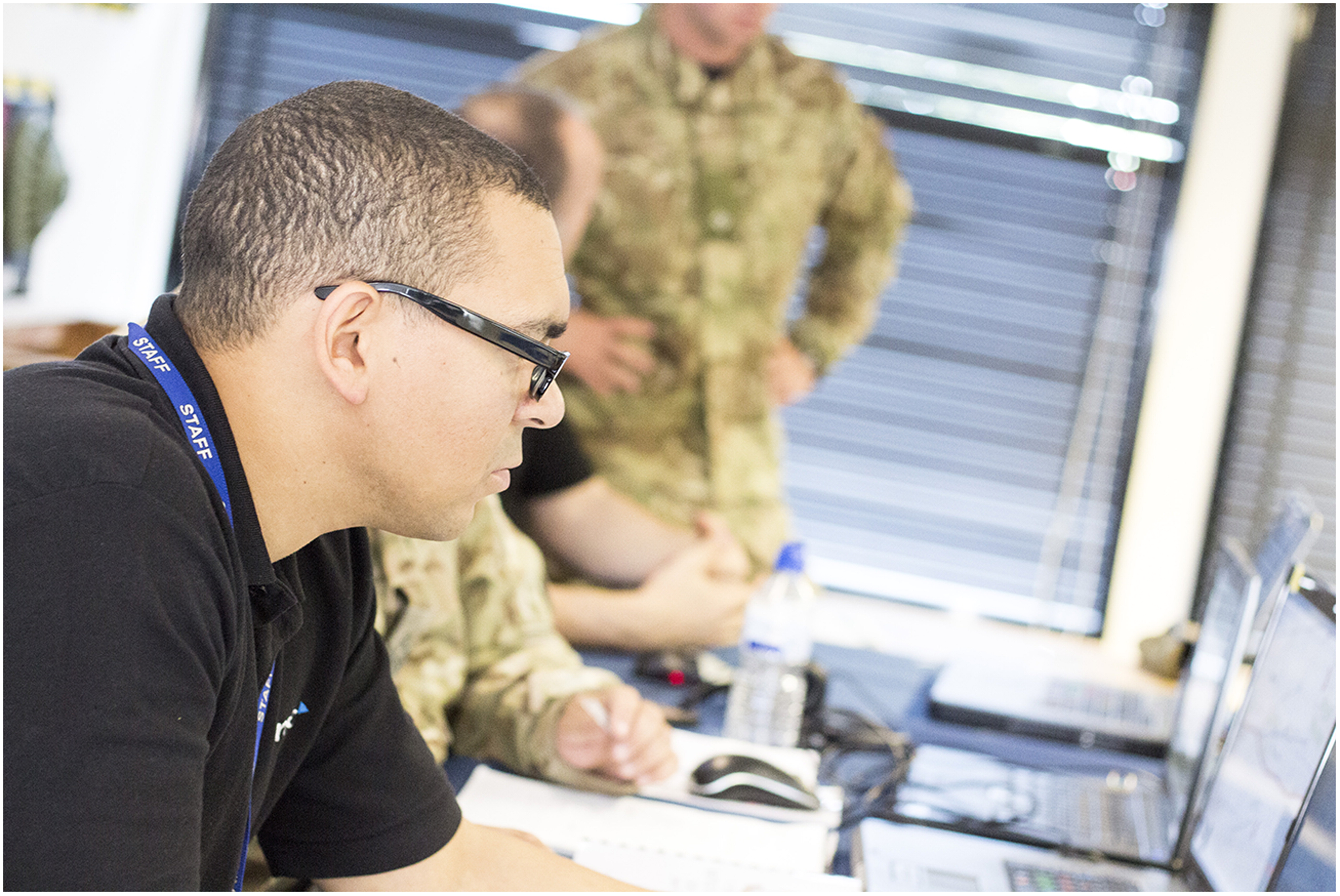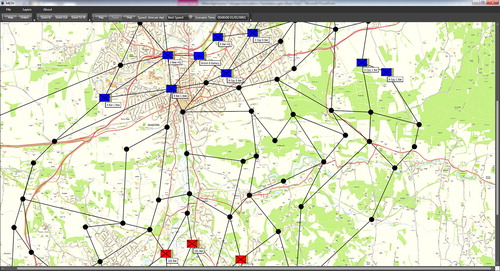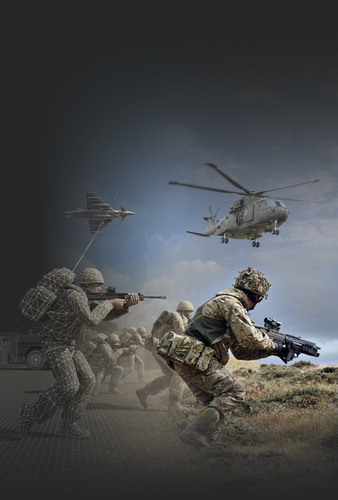
BEING CHARGED WITH ANSWERING THE STRATEGIC QUESTIONS posed by protecting the UK’s security, independence and interests at home and abroad does not mean those serving in Britain’s Armed Forces are immune to the pressures placed on other professions. Budgetary restraints and widely-reported recruitment and retention problems coupled with the need to meet emerging threats from states, including Russia, mean those in uniform face the inevitable challenge of doing more with less, despite the severity of the consequences of making a wrong call.
those in uniform face the inevitable challenge of doing more with less, despite the severity of the consequences of making a wrong call
Fortunately, the Services have an analytical ally in NSC – a simulation and training specialist on a mission to ease Defence’s decision-making burden and give the military the intellectual edge on the physical and digital battlefields of tomorrow. The company was responsible for introducing computer-based wargaming to the former Army Staff College in the 1980s and it has been using its mathematics and modelling expertise ever since to ensure the Armed Forces remain greater than the sum of their parts. , for instance, shows the digital equivalent of a traditional strategic map table. Over the past three decades, NSC’s analytical acumen has been deployed across Defence’s arms and agencies and assisted in procurement processes, measuring the effectiveness of capabilities, experimentation and the training of tens of thousands of front-line personnel.
The Defence Science and Technology Laboratory (Dstl) is among the beneficiaries of the Surrey-based firm, which boasts a permanent staff in excess of 40. NSC’s wide spectrum of support has ranged from qualitative visualisations to the development and evolution of campaign-level simulation models, with a focus on ensuring study teams are able to rely on the availability, utility and performance of these tools for years to come.
The company has worked on three of the five mission critical models used by Dstl’s Defence and Security Analysis division – WISE, CAEn and HLCM – re-engineering code to operate in the latest computing environments and utilising multi-processor and multi-threaded approaches to increase performance. Combined with its improved user interfaces, NSC’s endeavours have delivered dramatic results, with some tasks that once took analysts ten minutes now taking just ten seconds.
In respect of CAEn [Close Action Environment], a multi-sided, computer-based wargame representing all-arms close combat battles up to company group level, simulation runtime has been enhanced by a factor of 4.9. Such a significant upgrade has enabled Dstl to deliver studies at a scale previously impossible and consequently broadened the scope and variety of studies CAEn can now undertake on behalf of Defence.
NSC’s endeavours have delivered dramatic results, with some tasks that once took analysts ten minutes now taking just ten seconds
MISSION PLANNER
NSC’s detail for digits has also delivered Mission Planner – a decision-making, machine learning toolset which uses Artificial Intelligence (AI) and is currently applied at the tactical level of combat. Potentially easing the demand on Dstl’s operational research community, it could act as a force multiplier, supporting high-intensity warfighting simulations by reducing – or in some cases eliminating – the need for complex pre-scripting of simulated combat units or human-in-the-loop interactors.
Mission Planner exploits two stochastic optimisation AI techniques – genetic programming and a novel implementation of simulated annealing – and its algorithms are employed in a generic architecture that allows simple application to different problems.
The toolkit represents a significant upgrade to wargaming; an approach which was in danger of becoming prohibitively labour intensive as it evolved to reflect the fast-paced, flexible battle rhythm required for modern warfighting.
Rather than requiring analysts to generate the large number of order sets associated with manoeuvring units in a simulated battlespace, Mission Planner’s AI solution can quickly translate a commander’s high-level intent into low-level military objectives. Two decades ago such a simulation would have required in excess of 15 people inputting orders. Today only one is needed.
Although already key in the present, this capacity generator is set to become even more valuable in the future as the UK’s Armed Forces adapt to the challenges of hybrid warfare. The need to emulate a blend of conventional, political, cyber and information warfare strategies creates huge data demands.
Collaboration has always been a common theme of conflict, and any AI applied in the military domain, such as simulated units, actors or autonomous systems, must realistically collaborate to achieve a goal. Mission Planner achieves this effect through the use of military syntax in its algorithms that produce plans for tactical problems which resemble human decision making.
While cutting-edge, NSC’s proficiency in employing AI in simulation is not a new development. The Surrey-based firm demonstrated its pedigree in the field in 2000 when it used AI to automate the air planning and air tasking roles of an operational level simulation of a joint – land, air and maritime – battlespace.
Rather than the previous four people required to enter data for each country represented in the computer-assisted exercise, the innovation allowed for a single user per alliance to enter a joint prioritised target list and have the AI – using simulated annealing – determine the most appropriate action from the air assets available.
NSC demonstrated its pedigree in the field in 2000 when it used AI to automate the air planning and air tasking roles of an operational level simulation of a joint – land, air and maritime – battlespace
HIGH-LEVEL SUPPORT
Given the depth of its experience in mathematical modelling, NSC is unsurprisingly quick to champion the substantial merits of operational research to as wide an Armed Forces audience as possible and is responsible for refining future commanders’ understanding of the role it can play in informing military decision making.
The company has provided experienced analysts to the UK’s Joint Services Command and Staff College in Shrivenham for more than three years, exposing officers to the scientific and mathematical methods and skilled people available to support headquarters staff on operations.
Demonstrating how analytical research can calculate likely outcomes of military actions, NSC’s teams supply answers to questions posed by students during the exercise phases of the college’s Higher Command Staff, Advanced Command and Intermediate Command and Staff courses.
And NSC’s promotion of operational research is not confined to Britain’s shores. One of the company’s operational analysts spent two extended spells in The Hague helping NATO to identify the resources needed by the multinational organisation to meet its operational ambitions. He formed part of the NATO Communication and Information Agency team tasked with quantifying the military assets and efforts required from each of the Alliance’s member nations. Working closely with defence planners, the NSC secondee assisted in consolidating and mining data from 28 contributing countries to define future minimum capability requirements and identify any potential shortfalls.
Another member of the NSC team deployed to La Spezia in Italy to support NATO’s Centre for Maritime Research and Experimentation in the development of a strategy for its Multinational Shared Training concept. The role involved reviewing proposals for the structure of a combined action and implementation plan and examining the performance parameters of NATO stakeholders.
EXPERT ANALYSIS
Of course, the military’s embrace of operational research to deliver success in theatres of conflict is nothing new. It has been part of British military planning since the Second World War, when the use of mathematical models included showing that sailing supply ships in convoys reduced vulnerability to submarine attacks and that harmonising the machine guns on fighter aircraft increased lethality in a dog fight. In modern theatres it can be used to support a wide breadth of decision-making, from calculating the probability of success in land, maritime, air and counter-insurgency operations to answering logistical questions on movement and consumption rates.
However, despite the demand and prevalence of the use of operational research in a military context, NSC is one of only a handful of companies to specialise in the field. Steve Yates, Account Director for Research and Cyber at NSC, says the firm’s emergence as a prime provider to the Armed Forces is down to more than just its numerical nous and coding capabilities. ‘In addition to our understanding of languages such as Java, Python and C++, we speak our customers’ language’, he explained. ‘As a company we’ve worked with the military for more than a quarter of a century, been embedded in its training establishments, helped it to refine and develop enduring models and employ a large number of former Service personnel. Consequently, we don’t just crunch numbers, we understand the questions being asked, the problems posed and the context of any answers; we can translate computer language into military speak. There is no “analyst/soldier” divide and that is one of our greatest strengths’. This close working relationship can be seen in the lead image.
we understand the questions being asked, the problems posed and the context of any answers; we can translate computer language into military speak
VIRTUAL TRAINING
NSC’s comfort at the cutting-edge of technology is demonstrated by the British Army’s Unit Based Virtual Training (UBVT) system (see ). Designed and delivered as a managed service by the firm, UBVT immerses soldiers in high-fidelity terrains featuring authentic equipment and enables units to practise fire and manoeuvre, command and control, and tactics, techniques and procedures in preparation for live training opportunities and operational deployments.
The innovative system, which is available to all Regular and Reserve units and will provide virtual training to troops until at least 2020, has already been used by more than 2000 Servicemen and women at locations across the UK, Germany and Cyprus.
In an era of fiscal difficulty, simulation is essential to the Armed Forces. Rolling out brigades and battlegroups onto a real-world training area is an incredibly expensive and time-consuming business whereas the cost of a unit using UBVT for a week is equivalent to the fuel used by a single tank on exercise.
Being able to benefit the British Forces’ bottom line clearly puts providers of synthetic training in the box seat and the continual advancement of augmented and virtual reality platforms hints at an even brighter future for the simulation and modelling sector.
LEARNING LESSONS
However, despite spearheading the adoption of such technologies, NSC also has one eye firmly trained on the past. True to the company’s operational research roots, the consultancy provides the Centre for Historical Analysis and Conflict Research (CHACR) with its director, research staff and technical and project management experts.
An independent military think-tank, CHACR is tasked with ensuring the British Army is not out-thought on operations through the considered analysis of the lessons of the past.
NSC’S MODUS OPERANDI
NSC chief executive Jeremy Spurr commented: ‘Throughout our own history we’ve had to adapt to change and stay ahead of the trend. While faster, more powerful computers have enabled us to deliver increasingly immersive simulations and more complex models, the use of hi-tech hardware has not become NSC’s default solution. Although we were among the first to see the value of using a computer to support military training we have always been acutely aware that technology must not become the driver. One would always like bigger, more complex models but those are not always appropriate. In our field, effective operational research is not about producing data for data’s sake, it is about finding the best means to provide evidence that can be relied upon, understood and used to inform decisions’.
effective operational research is not about producing data for data’s sake, it is about finding the best means to provide evidence that can be relied upon, understood and used to inform decisions
Andrew Simms is the managing director of TylerBale Communications. An experienced journalist and editor, he has worked with and alongside the Armed Forces for nearly two decades and reported from an array of operational theatres, including Iraq, Afghanistan, Kosovo and Macedonia.


